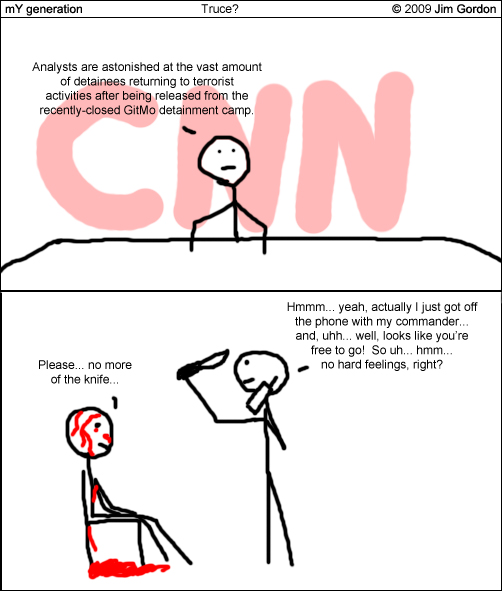|
|
|
Archive for January, 2009
Tuesday, January 27th, 2009
 When you build an edifice that you want to withstand the stresses of everyday living as well as crisis and catastrophe it’s important to include structural supports in the design. When you build an edifice that you want to withstand the stresses of everyday living as well as crisis and catastrophe it’s important to include structural supports in the design.
The same is true for corporate culture and I call them “infrastructure building blocks” or IBBs.
There are three categories of IBBs—philosophy, attitude/style, and policy. There are many things that can be included, but here is a list of the most basic ones, some are fairly self-explanatory, others include commentary and links where possible.
The philosophy category includes
- Fairness: pay parity, merit promotions, egalitarian policies,
- Open communications: not a technology function, but a part of MAP.
- Business 101: basic information to reduce/eliminate naiveté, fuzzy or rose-colored views of the company’s business.
- No surprises
- Pragmatism
The attitude/style category includes:
- Manager vigilance: a constant awareness of what is going on and a willingness to deal with the reality of it immediately.
- Management-by-walking-around
The policy category is the concrete expression of the Philosophy and Attitude/Style IBBs. Just as the Preamble to the Constitution delineates the doctrines underlying it, each Policy IBB supports one or more of the IBBs described above.
Policy IBBs should be reasonably broad—macro rather than micro—since they support a flexible process, not ossified bureaucracy. They are your most potent infrastructure—the most tangible and, therefore, the hardest to corrupt or ignore, but also the most dangerous, because they can turn into bureaucracy in the blink of an eye if you’re not careful.
- Business Mission Statement (BMS)
- Cultural Mission Statement (CMS)
- Dual Mission Statement (DMS)
- Open-door
- Management by Box: actually a way to set your people free
- Dual Ladder Career Path: a series of hands-on positions that equate straight across the board with management positions.
- Hiring process: transparent and painless and easy to use for both candidates and hiring managers.
- Stock bonus plan (or similar)
- Sales incentives
- Reviews: Done correctly, they encourage personal growth, make negative behavior much harder to conceal and can even act as a screening tool during interviews.
- Surveys: useful for discovering problems, attitudes, product directions, company standing, etc. as perceived by employees and selected outsiders.
One caveat when implementing these and other approaches: lead by example; both managers and workers will do as you do, not as you say.
Your comments—priceless
Don’t miss a post, subscribe via RSS or EMAIL
Image credit: flickr
Posted in Communication, Culture, Ducks In A Row, Entrepreneurship, management, What Leaders DO | 3 Comments »
Monday, January 26th, 2009
Today is the story of why it is better to ask than assume and how a so-called follower can lead. It all started with Denis’ post December 31 describing what was happening in his company.
“I do not trust the developers I work with to do the right thing,… I used to be able to trust people in the team to correct me and help me get better … Work is a lot less enjoyable when that trust is gone.”
Denis is a reader and we’ve gotten to know each other over the last year, so I asked what happened.
“Let me see management changed, over committed failed to motivate people. The more experienced and talented members of the team left which provided less structure and safe guards. Now as we know unmotivated people don’t give their best. They do just enough to satisfy their management.”
I asked for more details and our conversation moved to email over the next week and have Denis’ permission to share them.
Over the next week three were additional management changes and Denis didn’t sound hopeful about how things were likely to work out. There was a 9% company-wide staff reduction; Denis and three other people became the basis for a new team and its management was taken over by the group that was actually funding the project.
“My impression is that the manager who we report into now was forced to take our project by his business sponsors. The manager himself has a decent reputation though and is in the process of hiring someone to put between him and us.”
Regarding the culture,
“The company thinks of it has a consensus culture. In reality it is a company that works on loyalty networks and temporary alliances among peers.”
As you may have guessed, none of this was exactly a moral booster; in fact, you might call it management by rumor with the assumptions generally falling on the negative side.
Typically, when stuff like this is happening, people’s reaction is to hunker down and polish their resumes, but, in spite of his assumptions, Denis took a chance with a more direct approach that yielded extremely positive results.
“The meeting was triggered by an email I sent expressing interest in him explaining his vision and how we fit in it. I was requesting a one on one but he made the meeting for the whole team. He took 1h 45 minutes of his time to talk when 1h was planned. And he mentioned we will do a social event for the whole group so we get to meet everyone.
So far he is the most competent manager I have met in this company. My direct manager has not joined the group yet but I hear good things about him so there is hope.”
We’ll never know what would have happened if Denis hadn’t sent the email; if the manager is as good as he seems to be he probably would have done the same thing, but maybe not quite as soon and likely with much more damage.
There are at least three important lessons to be learned
- Remember that the result of no communications is a rumor-ravaged workforce and that once started rumors never go away.
- There are better ways for workers to handle difficult situations than to hunker down or just sit and wait; they can take the initiative and ask for information; most managers will appreciate the request.
What else can be learned from this?
Your comments—priceless
Don’t miss a post, subscribe via RSS or EMAIL
Image credit:
Posted in About Leadership, Communication, Culture, Followers, Leaders Who DO, management | 4 Comments »
Monday, January 26th, 2009
Corporate culture only recently came into its own; no longer something more smoke and mirrors than real.
These days, academics, pundits and gurus of all stripes research, dissect, write, discuss, preach, teach, and study it, all with the goal of defining it so it can be improved.
It’s still considered a soft science, a moving target, amorphous and difficult to pin down and is often influenced by unlikely sources as opposed to the expected ones.
How in the world can that be compared to a computer, with its unyielding hardware and logical, literal software?
 In computing, the term I/O refers to input, whatever is received by the system, and output, that which results from the processing. In computing, the term I/O refers to input, whatever is received by the system, and output, that which results from the processing.
Programmers know that the results coming out of the computer won’t be any better than the information given it and this phenomenon is know as “garbage in/garbage out.”
And there you have the similarity with culture and everything else in life.
What comes out is a function of what you put in.
Blindly accepting everything offered by even the most brilliant source will result in garbage out at some point.
Learning/improving requires critical thinking on your part. No one person, past, present or future, has all the answers. You need to evaluate the available information, take a bit from here and a bit from there, apply it to your situation and, like a computer, process it. The result will be at least slightly different from what you started with because you’ve added the flavor of your own life experiences, knowledge and MAP to the mix—and that’s good, it shouldn’t be an exact copy.
Culture is a living organism, growing and changing all the time and you’re contributing to that growth.
Image credit: flickr
Posted in Business info, Culture | No Comments »
Sunday, January 25th, 2009
Just one quote today—one that’s depressing and sad and makes me very angry.
 In a speech in 1962 then-President John F. Kennedy said In a speech in 1962 then-President John F. Kennedy said
“The American people will find it hard to accept a situation in which a tiny handful of steel executives whose pursuit of private power and profit exceeds their sense of public responsibility can show such utter contempt for the interests of 185 million Americans.”
I’m angry because 47 years later it’s déjà vu, all you need to do is change “steel” to “bank.”
But the real question is whether whoever is elected in 2056 will face yet another set of executives who also hold the American people in such total contempt.
Unless it happens sooner…
Your comments—priceless
Don’t miss a post, subscribe via RSS or EMAIL
Image credit: flickr
Posted in About Leadership, Ethics, Leadership Quotes, Quotable Quotes, What Leaders DON'T | No Comments »
Sunday, January 25th, 2009
See all mY generation posts here.

Posted in mY generation, Politics | No Comments »
Saturday, January 24th, 2009
 Even in bad times even companies that are laying off may have critical positions to fill. Managers want to be sure that they get the highest value possible from that position, since it may be their only new hire in 2009. Even in bad times even companies that are laying off may have critical positions to fill. Managers want to be sure that they get the highest value possible from that position, since it may be their only new hire in 2009.
The tendency is to look for a star—super person who can not only bring home the bacon, but smoke it first.
According to HBS professors Boris Groysberg, Lex Sant, and Robin Abrahams that may not be your best bet.
“Our research shows that stars whose jobs require them to cooperate and collaborate with other workers have a hard time maintaining performance when they move to a new organization.”
Read the interview and their research and then think deeply about the value of hiring an outside “star” for your critical opening.
Paul Brown’s Tool Kit column is an excellent resource and this one is well worth your time. In it he shares links to great resources showing the value of keeping your company small.
Go ahead and chow down, there’s lots of food for thought and action this week.
Image credit: flickr
Posted in Business info, Culture, Hiring, Innovation, Motivation, Retention | No Comments »
Saturday, January 24th, 2009
 Six weeks ago I started Seize Your Leadership Day; each post had info and links to resources or articles I felt would interest/be or use to you. Six weeks ago I started Seize Your Leadership Day; each post had info and links to resources or articles I felt would interest/be or use to you.
Based on your reaction to date, it’s been of little use to you—a giant yawn.
So I thought I’d ask you directly, do you like the feature?
If so, is the content I find of use to you or does it need refining?
If not, what would you like to see here on Saturdays?
Please don’t be shy. The worst thing for any blogger is to ask for guidance from readers and not get any. Makes us wonder if anyone is reading.
In the meantime, Here are a couple of goodies for today.
Margaret Heffernan’s two most recent posts (1/6 and 13) are the start of a series and offer smart, real-life examples on dealing with the recession. As Heffernan says,
“Think of recessions as tests. Companies that fail them die. Companies that survive live to fight another day. But a few companies emerge stronger than ever.”
They’re short, with solid lessons and ideas for you to start using immediately.
Another useful reminder for recession managing comes in an 18 month old article in Business Week on the value of failure in achieving success. It’s more important in today’s economy than it was then, because without a safe environment in which to fail there can be no innovation and a company without innovation is a company on the slippery, downward slope to mediocrity—or worse.
I hope they’re of use to you.
Don’t forget to leave your thoughts and preferences for Saturday subjects as requested earlier. If you’d rather send them for privacy, you can reach me at miki@RampUpSolutions.com (please put Leadership Turn in the subject line to avoid filters).
Your comments—priceless
Don’t miss a post, subscribe via RSS or EMAIL
Image credit: flickr
Posted in About Leadership, Culture, Entrepreneurship, Innovation, Leaders Who DO, Leadership Skills, management, Seize Your Leadership Day | 2 Comments »
Friday, January 23rd, 2009
 About two-thirds of the way through a January 7th CNBC interview with President Barack Obama when the conversation turned to his Blackberry, Obama talked about his reasons for wanting to keep it, even in the face of vehement opposition. (The bolding is mine.) About two-thirds of the way through a January 7th CNBC interview with President Barack Obama when the conversation turned to his Blackberry, Obama talked about his reasons for wanting to keep it, even in the face of vehement opposition. (The bolding is mine.)
“What it has to do with is having mechanisms where you are interacting with people who are outside of the White House in a meaningful way. And I’ve got to look for every opportunity to do that–ways that aren’t scripted, ways that aren’t controlled, ways where, you know, people aren’t just complimenting you or standing up when you enter into a room, ways of staying grounded.”
That bubble and associated danger, is what every boss, from the CEO of a Fortune 50 to small business owners, face every day.
The danger is real and comes from hearing only what a small group of people wants you to hear; all the news that fits the generally accepted world view and nothing that will upset their applecarts or you (in that order).
Technology can help, but it can also be a way to avoid interacting in a more personal manner. After all, it’s doubtful that you’re trying to stay connected to millions.
Where you can, you want to practice management by walking around, not just internally, but out with your customers and vendors.
When you can’t do it in person, use technology for town hall meetings; use wikis, blogs, and forums, too. Sharing your email address and encouraging contact can be very positive, but it’s worse than nothing if you don’t respond in a timely manner.
So make a list of possibilities and prioritize them.
But first things first—think through your circumstances in order to determine not just what you can afford financially, but in terms of time and energy—yours.
Your comments—priceless
Don’t miss a post, subscribe via RSS or EMAIL
Image credit: sxc.hu
Posted in About Leadership, Communication, Culture, Followers, management, Personal Development, What Leaders DO | 4 Comments »
Friday, January 23rd, 2009

I frequently tell clients and readers to slow down; unwire themselves; learn to say no.
So my next rule may sound counterproductive, but it’s not.
Don’t live with the brakes on!
Taking off the brakes isn’t about going faster, it’s about taking time for the stuff that stops when you move too fast—such as creativity.
So take the brakes off your imagination; take time to dream; make more time for doing nothing and watch your world expand and sizzle.
Image credit: sxc.hu
Posted in Innovation, Miki's Rules to Live by | No Comments »
Thursday, January 22nd, 2009
 I’ve focused a lot over the last six months on the problems in education and attitudes of the workforce-to-be and it’s been a pretty dismal picture. Obviously, there are plenty of exceptions, but that, too, is problematic. I’ve focused a lot over the last six months on the problems in education and attitudes of the workforce-to-be and it’s been a pretty dismal picture. Obviously, there are plenty of exceptions, but that, too, is problematic.
It’s not just that entrepreneurship attracts the best and brightest, is also attracts a significant percentage of high-initiative students and it’s those with initiative who drive innovation wherever they’re at.
And there lies the problem.
Not because these kids want to solve problems, start businesses and attack the world’s social ills—that’s great. But the MAP that drives these kids is the same MAP that is so desperately needed by today’s corporations.
“”They’re [the Net generation] great collaborators, with friends, online, at work,” Mr. [Don] Tapscott wrote. “They thrive on speed. They love to innovate.” … A report issued last year by the Kauffman Foundation, which finances programs to promote innovation on campuses, noted that more than 5,000 entrepreneurship programs are offered on two- and four-year campuses — up from just 250 courses in 1985…Since 2003, the Kauffman Foundation has given nearly $50 million to 19 colleges and universities to build campus programs.”
We live in a world of impatience; Boomers, contrary to some perceptions, were and are impatient; Gen X is still more impatient and it’s increased by an order of magnitude in Gen Y—and it will continue to increase the faster the world moves and changes.
And, to paraphrase, the world, it is a changin’.
The youngest generation is the most impatient, and that impatience is traveling up.
Yet, it is those with initiative, not just impatience; those with a desire to accomplish, not a sense of entitlement, that companies need to attract if they want to compete and thrive in the new world.
These are the people who can fuel innovation and corporate America’s ability to succeed.
These are the people you have to hire and manage.
Are you ready?
Your comments—priceless
Don’t miss a post, subscribe via RSS or EMAIL
Image credit: flickr (Click the picture if you’re having trouble reading it.)
Posted in About Leadership, Change, Entrepreneurship, Innovation, Leadership's Future | No Comments »
|
 Subscribe to
Subscribe to
MAPping Company Success
About Miki 
Clarify your exec summary, website, etc.
Have a quick question or just want to chat? Feel free to write or call me at 360.335.8054
The 12 Ingredients of a Fillable Req
CheatSheet for InterviewERS
CheatSheet for InterviewEEs™
Give your mind a rest. Here are 4 quick ways to get rid of kinks, break a logjam or juice your creativity!
Creative mousing
Bubblewrap!
Animal innovation
Brain teaser
The latest disaster is here at home; donate to the East Coast recovery efforts now!
Text REDCROSS to 90999 to make a $10 donation or call 00.733.2767. $10 really really does make a difference and you'll never miss it.
And always donate what you can whenever you can
The following accept cash and in-kind donations: Doctors Without Borders, UNICEF, Red Cross, World Food Program, Save the Children
*/
?>About Miki
About KG
Clarify your exec summary, website, marketing collateral, etc.
Have a question or just want to chat @ no cost? Feel free to write
Download useful assistance now.
Entrepreneurs face difficulties that are hard for most people to imagine, let alone understand. You can find anonymous help and connections that do understand at 7 cups of tea.
Crises never end.
$10 really does make a difference and you’ll never miss it,
while $10 a month has exponential power.
Always donate what you can whenever you can.
The following accept cash and in-kind donations:
|
 When you build an edifice that you want to withstand the stresses of everyday living as well as crisis and catastrophe it’s important to include structural supports in the design.
When you build an edifice that you want to withstand the stresses of everyday living as well as crisis and catastrophe it’s important to include structural supports in the design.



 In computing, the term I/O refers to input, whatever is received by the system, and output, that which results from the processing.
In computing, the term I/O refers to input, whatever is received by the system, and output, that which results from the processing. In a speech in 1962 then-President John F. Kennedy said
In a speech in 1962 then-President John F. Kennedy said
 Even in bad times even companies that are laying off may have critical positions to fill. Managers want to be sure that they get the highest value possible from that position, since it may be their only new hire in 2009.
Even in bad times even companies that are laying off may have critical positions to fill. Managers want to be sure that they get the highest value possible from that position, since it may be their only new hire in 2009. Six weeks ago I started
Six weeks ago I started  About two-thirds of the way through a
About two-thirds of the way through a 
 I’ve focused a lot over the last six months on the problems in education and attitudes of the workforce-to-be and it’s been a pretty dismal picture. Obviously, there are plenty of exceptions, but that, too, is problematic.
I’ve focused a lot over the last six months on the problems in education and attitudes of the workforce-to-be and it’s been a pretty dismal picture. Obviously, there are plenty of exceptions, but that, too, is problematic.
